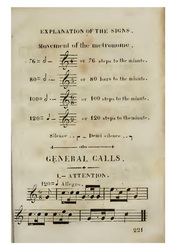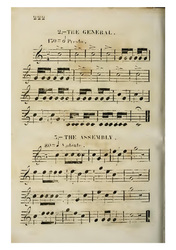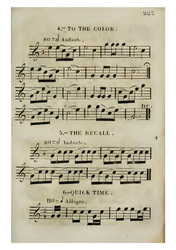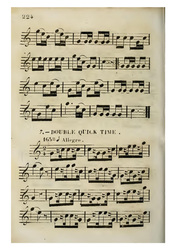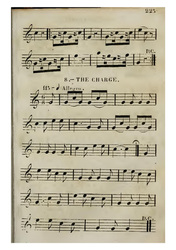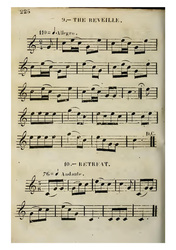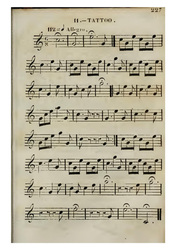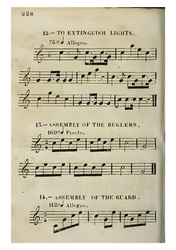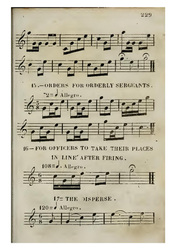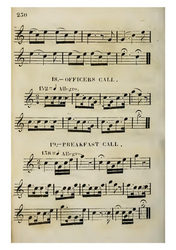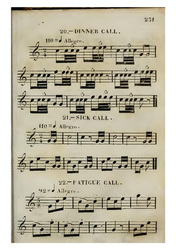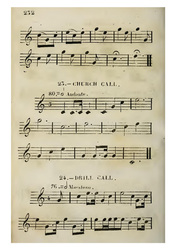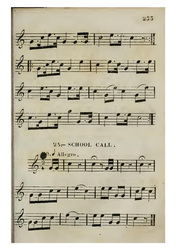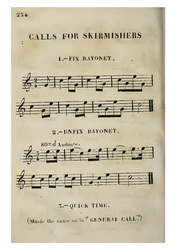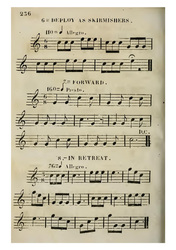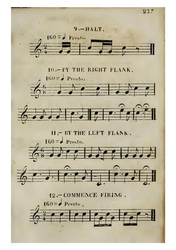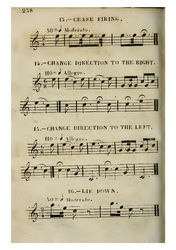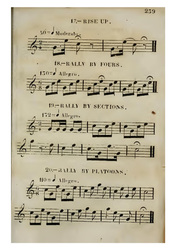ADMIRAL RAPHAEL SEMMES CAMP #11
SONS OF CONFEDERATE VETERANS
MOBILE, ALABAMA
Training and Life
of the
Confederate Soldier
The Rebel Yell
The video below was published in the Smithsonian Magazine. The article discusses the few video recordings in the Smithsonian archives of veterans of the War between the States.
SOLDIERING BY THE BOOK
The book Rifle and Infantry Tactics written by General William Hardee when he was a brevet lieutenant in the US Army was originally published in 1855. In 1861, it was republished for the Confederate troops. The downloadable file is a copy of the 1861 version published in Memphis. However, this was not the official Confederate soldier copy.
| Hardees Rifle and Infantry Tactics.pdf | |
| File Size: | 8036 kb |
| File Type: | |
the official soldiering manual was published in mobile, al
In February 1861, the Confederate States of America was formed. From that point on for over four years, the citizens of Mobile found themselves gradually cut off from the material resources of the North, and because of Union blockades, they had limited access to those of England and Europe. Regardless of difficulties that lay ahead, S. H. Goetzel & Co. lost no time in proving to the North—and the rest of the Confederacy—that the Deep South and, specifically, Mobile, would continue to publish.
The firm’s first Confederate project provided the newly formed army with a previously published military work by William J. Hardee, briefly described in this 21 May advertisement.
S. H. GOETZEL & CO.
Beg to inform the public that they have in press, by authority of the distinguished author and by copyright of the Confederate States, several editions of HARDEE’S REVISED AND IMPROVED INFANTRY AND RIFLE TACTICS, which will be shortly issued.
The Publishers succeeded in employing one of the most SKILLFUL ENGRAVERS FOR THE PLATES, and two of our BEST PRINTING OFFICES are engaged in the Press work, and every effort will be made to bring the Work out in a becoming style, and at the same time, as quick as possible. S. H. Goetzel& Co. MOBILE, Ala.27
The very first edition of this work, re-titled Rifle and Infantry Tactics, Revised and Improved, was a two-volume, octavo pamphlet, bound in paper wrappers. This was quickly followed by the two-volume, “fine bound edition” in the smaller twenty-four-mo format, also denoted as the first edition. While a second octavo edition was printed, that format was dropped in favor of nine editions of the 24mo book.
In the 25 June 1861 issue of the Mobile Advertiser and Register, a long letter from Goetzel described the copyright details, as well as the materials and personnel employed in the first editions of Hardee’s Tactics.
"We…secured the copyright from the Confederacy, and made an offer to Congress, which was then in session at Montgomery.
Notwithstanding the disadvantages under which we have to labor here in comparison with Philadelphia, still we proposed to publish for the Confederate States army at a dollar a copy, (the same price at which Lippincott sold 18,000 copies,) and would take payment in bonds of the Confederacy, provided that the Government would order at least 5,000 copies. Nor would we ask any further compensation for the plates or for the engravings. At the same time we stated that it was our earnest intention to make Mobile a great publishing place, and if the Government will encourage our efforts, it may prove beneficial to the whole confederacy. The Committee on Military Affairs was fully convinced of the general benefit of our offer, and made the report to buy 10,000 copies at our price and terms, but when it came into Congress that motion was lost, and for the simple reason that so many spurious editions of Hardee’s Tactics were announced at the same time.
In the meantime, it has been sufficiently developed itself that not one of those has really published Hardee’s Tactics. Nevertheless, we went to work.
Mr. J[ohn] Y. Thompson took a great interest in our issue, and to him it is due, that we were able to bring out the first volume 8vo. in pamphlet in less than eight days. That is decidedly the quickest job of the kind that ever was done in our city, and all those who are initiated in the craft will give him credit for the neatness with which the work is done. To us it is gratifying to have learned how much can be done here if we only are determined to keep to each other and to assist each other. Even the superior paper we used is of Southern manufacture, being purchased of Mr. Gilbert, whose house is the Mobile branch of the Rock Island Mills, [Columbus,] Georgia.
The next in turn is our excellent engraver, W[illiam] R. Robertson, whose skill and taste, united with great zeal and industry, furnished us with such splendid lithographs that our plates now are superior to the Lippincott edition. That shows again how much can be done in Mobile.
After the printers and engravers exerted themselves to the utmost of their capacity, we must also acknowledge that the binders have done more than ever was performed here in that line. Mr. Schr[ieber] bound 1,000 pamphlets in not quite a week, and Mr. Eastburn put the plates in, on the average of about 1,000 copies a week, and finished at the same time many hundreds of the fine bound edition.
Now, those things are all very easy where there are plenty of cutting, gilding [die stamping] and binding machines, but here, where everything has to be done by hand, it is really astonishing how quick the blockade has transformed us as to manufacturing and self-sustaining people, and who ever wants anything done in the binding line, we can recommend our home binders for such job.
Speaking of our fine edition—we will also state that the job office of the Register undertook one volume, and Mr. Thompson printed the other, and by that good understanding we were enabled to bring out those various editions, and so many thousands of each, in so short a time.
Now, in giving all those facts, we have no other purpose but to show what Mobile can perform in the book line, and hope that it will attract the attention of our people at home and abroad. S. H. GOETZEL & CO. Mobile, June 24th, 1861.28"
As several pirated, northern and southern editions of Hardee’s work were announced just as Goetzel was preparing its production, “THE ONLY COPY-RIGHT EDITION” was printed boldly over the title. To drive the point home, Hardee placed a “card” in the Mobile newspapers (and possibly in other southern papers) confirming that S. H. Goetzel & Co.’s edition was the only sanctioned one. He also might have commissioned Goetzel to issue a small broadside, “NOTICE.,” affirming the copyright. With either the sixth or the seventh edition, this broadside was included in the front matter in volume one.
Through the third edition, the imprint of Hardee’s Tactics is dated "THE FIRST YEAR OF THE CONFEDERACY," indicating that the title was in great demand. Reprinting continued until the ninth and last edition, available by May 1864. On 14 December 1863, the publisher and author submitted a six-page, printed memorial to the CSA Congress, asking for a special copyright for Tactics, which was granted at the end of the year. The resulting bill stipulated that either or both could enter the copyright in any district court in the Confederacy, and once secured, it would “continue in force fourteen years from the approval of this act.”29 The ninth edition, however, still carries the 1861 copyright notice.
William R. Robertson, the local “engraver,” appears to have copied the plates from those appearing in the two-volume, 24mo, 1860 edition of the work published by J. B. Lippincott & Co. While the Lippincott book reproduced the twenty pages of music with a font of music type, apparently this was not available in the Mobile printing office concerned with producing volume one.30 For the Mobile editions, the music was lithographed onto large sheets of papers, cut and folded, and inserted into the last signature in volume one. It appears that for various editions, some of the lithographic plates were redrawn and printed. The typesetting of the smaller format Mobile edition is almost identical to that of the 1860 Lippincott edition.
Examination of most of the 24mo editions of Tactics confirms that the binding continued to be done by hand, presumably by Schrieber and Eastburn. For example, the covers of the second edition were full-leather with hand-tooled gold lettering on the spine, while the third edition was quarter leather with morocco grain pattern cloth sides (similar to the one found on the 1860 Lippincott edition). The use of grained cloth indicates that this material was smuggled into Mobile, probably from England, the primary country of its manufacture. The binding of the ninth edition is quarter-bound in a glazed, white, ungrained cloth with wallpaper sides.
At the end of 1861, while reprinting Tactics, S. H. Goetzel & Co. published a ten-page pamphlet titled Rules of Practice Under the Sequestration Act…. This was the first of two small publications the firm published on behalf of the CSA, the second one being Standing Interrogatories in Prize Causes…, issued in 1863, comprising eight pages. For most of 1862, S. H. Goetzel & Co.’s publishing efforts were focused on reprinting titles and arranging for the appearance of new ones. (Discussed in more detail below, this year was also filled with personal anxiety as Goetzel was divorcing his first wife and suffering the debilitating effects of consumption.)
The original Mobile document published by Goetzel is included below.
The firm’s first Confederate project provided the newly formed army with a previously published military work by William J. Hardee, briefly described in this 21 May advertisement.
S. H. GOETZEL & CO.
Beg to inform the public that they have in press, by authority of the distinguished author and by copyright of the Confederate States, several editions of HARDEE’S REVISED AND IMPROVED INFANTRY AND RIFLE TACTICS, which will be shortly issued.
The Publishers succeeded in employing one of the most SKILLFUL ENGRAVERS FOR THE PLATES, and two of our BEST PRINTING OFFICES are engaged in the Press work, and every effort will be made to bring the Work out in a becoming style, and at the same time, as quick as possible. S. H. Goetzel& Co. MOBILE, Ala.27
The very first edition of this work, re-titled Rifle and Infantry Tactics, Revised and Improved, was a two-volume, octavo pamphlet, bound in paper wrappers. This was quickly followed by the two-volume, “fine bound edition” in the smaller twenty-four-mo format, also denoted as the first edition. While a second octavo edition was printed, that format was dropped in favor of nine editions of the 24mo book.
In the 25 June 1861 issue of the Mobile Advertiser and Register, a long letter from Goetzel described the copyright details, as well as the materials and personnel employed in the first editions of Hardee’s Tactics.
"We…secured the copyright from the Confederacy, and made an offer to Congress, which was then in session at Montgomery.
Notwithstanding the disadvantages under which we have to labor here in comparison with Philadelphia, still we proposed to publish for the Confederate States army at a dollar a copy, (the same price at which Lippincott sold 18,000 copies,) and would take payment in bonds of the Confederacy, provided that the Government would order at least 5,000 copies. Nor would we ask any further compensation for the plates or for the engravings. At the same time we stated that it was our earnest intention to make Mobile a great publishing place, and if the Government will encourage our efforts, it may prove beneficial to the whole confederacy. The Committee on Military Affairs was fully convinced of the general benefit of our offer, and made the report to buy 10,000 copies at our price and terms, but when it came into Congress that motion was lost, and for the simple reason that so many spurious editions of Hardee’s Tactics were announced at the same time.
In the meantime, it has been sufficiently developed itself that not one of those has really published Hardee’s Tactics. Nevertheless, we went to work.
Mr. J[ohn] Y. Thompson took a great interest in our issue, and to him it is due, that we were able to bring out the first volume 8vo. in pamphlet in less than eight days. That is decidedly the quickest job of the kind that ever was done in our city, and all those who are initiated in the craft will give him credit for the neatness with which the work is done. To us it is gratifying to have learned how much can be done here if we only are determined to keep to each other and to assist each other. Even the superior paper we used is of Southern manufacture, being purchased of Mr. Gilbert, whose house is the Mobile branch of the Rock Island Mills, [Columbus,] Georgia.
The next in turn is our excellent engraver, W[illiam] R. Robertson, whose skill and taste, united with great zeal and industry, furnished us with such splendid lithographs that our plates now are superior to the Lippincott edition. That shows again how much can be done in Mobile.
After the printers and engravers exerted themselves to the utmost of their capacity, we must also acknowledge that the binders have done more than ever was performed here in that line. Mr. Schr[ieber] bound 1,000 pamphlets in not quite a week, and Mr. Eastburn put the plates in, on the average of about 1,000 copies a week, and finished at the same time many hundreds of the fine bound edition.
Now, those things are all very easy where there are plenty of cutting, gilding [die stamping] and binding machines, but here, where everything has to be done by hand, it is really astonishing how quick the blockade has transformed us as to manufacturing and self-sustaining people, and who ever wants anything done in the binding line, we can recommend our home binders for such job.
Speaking of our fine edition—we will also state that the job office of the Register undertook one volume, and Mr. Thompson printed the other, and by that good understanding we were enabled to bring out those various editions, and so many thousands of each, in so short a time.
Now, in giving all those facts, we have no other purpose but to show what Mobile can perform in the book line, and hope that it will attract the attention of our people at home and abroad. S. H. GOETZEL & CO. Mobile, June 24th, 1861.28"
As several pirated, northern and southern editions of Hardee’s work were announced just as Goetzel was preparing its production, “THE ONLY COPY-RIGHT EDITION” was printed boldly over the title. To drive the point home, Hardee placed a “card” in the Mobile newspapers (and possibly in other southern papers) confirming that S. H. Goetzel & Co.’s edition was the only sanctioned one. He also might have commissioned Goetzel to issue a small broadside, “NOTICE.,” affirming the copyright. With either the sixth or the seventh edition, this broadside was included in the front matter in volume one.
Through the third edition, the imprint of Hardee’s Tactics is dated "THE FIRST YEAR OF THE CONFEDERACY," indicating that the title was in great demand. Reprinting continued until the ninth and last edition, available by May 1864. On 14 December 1863, the publisher and author submitted a six-page, printed memorial to the CSA Congress, asking for a special copyright for Tactics, which was granted at the end of the year. The resulting bill stipulated that either or both could enter the copyright in any district court in the Confederacy, and once secured, it would “continue in force fourteen years from the approval of this act.”29 The ninth edition, however, still carries the 1861 copyright notice.
William R. Robertson, the local “engraver,” appears to have copied the plates from those appearing in the two-volume, 24mo, 1860 edition of the work published by J. B. Lippincott & Co. While the Lippincott book reproduced the twenty pages of music with a font of music type, apparently this was not available in the Mobile printing office concerned with producing volume one.30 For the Mobile editions, the music was lithographed onto large sheets of papers, cut and folded, and inserted into the last signature in volume one. It appears that for various editions, some of the lithographic plates were redrawn and printed. The typesetting of the smaller format Mobile edition is almost identical to that of the 1860 Lippincott edition.
Examination of most of the 24mo editions of Tactics confirms that the binding continued to be done by hand, presumably by Schrieber and Eastburn. For example, the covers of the second edition were full-leather with hand-tooled gold lettering on the spine, while the third edition was quarter leather with morocco grain pattern cloth sides (similar to the one found on the 1860 Lippincott edition). The use of grained cloth indicates that this material was smuggled into Mobile, probably from England, the primary country of its manufacture. The binding of the ninth edition is quarter-bound in a glazed, white, ungrained cloth with wallpaper sides.
At the end of 1861, while reprinting Tactics, S. H. Goetzel & Co. published a ten-page pamphlet titled Rules of Practice Under the Sequestration Act…. This was the first of two small publications the firm published on behalf of the CSA, the second one being Standing Interrogatories in Prize Causes…, issued in 1863, comprising eight pages. For most of 1862, S. H. Goetzel & Co.’s publishing efforts were focused on reprinting titles and arranging for the appearance of new ones. (Discussed in more detail below, this year was also filled with personal anxiety as Goetzel was divorcing his first wife and suffering the debilitating effects of consumption.)
The original Mobile document published by Goetzel is included below.
Your browser does not support viewing this document. Click here to download the document.
Daily life of a Confederate soldier:
sergeant Charles jacob armstrong,
Company c of the 33rd alabama infantry
(as he recorded it in his diary)
Brief Bio of Charles Jacob Armstrong:
Charles Jacob Armstrong (he went by Jacob) was born in Butler, Alabama on 3 April 1834 to John Wesley Armstrong and Emily Jane Ferguson. He is listed at the age of 16 living with his father in Butler in the United States Federal census of 1850. We know he was a member of Company C of the 33rd Alabama Infantry. He enlisted in Greenville, Alabama as a private on 1 March 1862. He received a wrist wound in the battle of Chickamauga. He was medically discharged (retired) as a sergeant 3 Oct 1864 after having his leg amputated for a gunshot wound at the battle of New Hope Church. He received an artificial limb from the Confederate Army and subsequently received two legs from the US Federal government worth $70.00 in 1875. He also received a pension in the range of $1.50 per month. In the 1880 United States Federal Census, he was listed as a county tax assessor. He was listed with his wife, Elizabeth, his daughters Mattie (10) and Bulia (6), and his son, William (4). He died in Butler on 16 December 1892. He is buried in Magnolia Cemetery in Greenville, Alabama.
The images of Sgt. Armstrong's diary are part of the textural materials, which may be found on the Alabama Department of Archives and History, Montgomery, Alabama website (ADAH Digital Collections).
Charles Jacob Armstrong (he went by Jacob) was born in Butler, Alabama on 3 April 1834 to John Wesley Armstrong and Emily Jane Ferguson. He is listed at the age of 16 living with his father in Butler in the United States Federal census of 1850. We know he was a member of Company C of the 33rd Alabama Infantry. He enlisted in Greenville, Alabama as a private on 1 March 1862. He received a wrist wound in the battle of Chickamauga. He was medically discharged (retired) as a sergeant 3 Oct 1864 after having his leg amputated for a gunshot wound at the battle of New Hope Church. He received an artificial limb from the Confederate Army and subsequently received two legs from the US Federal government worth $70.00 in 1875. He also received a pension in the range of $1.50 per month. In the 1880 United States Federal Census, he was listed as a county tax assessor. He was listed with his wife, Elizabeth, his daughters Mattie (10) and Bulia (6), and his son, William (4). He died in Butler on 16 December 1892. He is buried in Magnolia Cemetery in Greenville, Alabama.
The images of Sgt. Armstrong's diary are part of the textural materials, which may be found on the Alabama Department of Archives and History, Montgomery, Alabama website (ADAH Digital Collections).
Your browser does not support viewing this document. Click here to download the document.
Brief History of the 33rd Alabama Infantry Regiment:
The Thirty-third Alabama Infantry Regiment was organized at Pensacola, FL, on 23 April 1862, with men recruited from Butler, Coffee, Covington, Dale, and Montgomery counties. It proceeded to Corinth just after the Battle of Shiloh. Placed in the brigade commanded by Col. Hawthorn of Arkansas, the regiment remained at Tupelo until the Kentucky Campaign began. It was part of the brigade of Gen'l Sterling A. M. Wood of Lauderdale, General Simon Buckner's Division, and was present at the capture of Munfordsville. At Perryville, the Thirty-third entered that conflict about 500 strong, and came out with but 88 rank and file. It came out of Kentucky with the army, and at Murfeesboro the loss of the regiment was comparatively large, for it was in Gen'l Patrick Cleburne's Division. The remainder of the winter was spent in camps near Tullahoma, and the regiment retired behind the Tennessee River during the summer. In the grand forward movement on the enemy's line at Chickamauga, the Thirty-third lost 149 casualties. Gen'l Mark Perrin Lowrey of Mississippi relieved Gen'l Wood after the latter was wounded and assumed command of the brigade [16th, 33rd Mississippi regiments, and J. H. Gibson's (18th AL) and Newman's (TN) battalions] the Thirty-third was effectively engaged at Missionary Ridge without loss. It was part of the wall of fire that checked the exultant federals at Ringgold Gap, where it lost but one man. The regiment passed the winter at Dalton, and was in the incessant battle from there to Atlanta, fighting during the day and entrenching at night, and losing many by the casualties of battle, particularly at New Hope Church, and around Atlanta. Having followed Gen'l John Bell Hood into Tennessee, it moved to the assault of the enemy's works at Franklin, with 285 men, and lost over two-thirds of them, mostly killed. Transferred to North Carolina, the Thirty-third took part in the operations there, and a remnant was there surrendered.
Field and staff officers: Cols. Samuel Adams (Butler; wounded, Perryville; KIA, Kennesaw Mountain); Robert F. Crittenden (Coffee; resigned); Robert F. Crittenden (promoted); James H. Dunklin (Butler); Majors Robert F. Crittenden (promoted); James H. Dunklin (wounded, Chickamauga; promoted); and Adjutants John Crosby Stallworth (Conecuh; died, Tupelo); A. M. Moore (Greene; KIA, Chickamauga); Willis J. Milner (Butler)
The Thirty-third Alabama Infantry Regiment was organized at Pensacola, FL, on 23 April 1862, with men recruited from Butler, Coffee, Covington, Dale, and Montgomery counties. It proceeded to Corinth just after the Battle of Shiloh. Placed in the brigade commanded by Col. Hawthorn of Arkansas, the regiment remained at Tupelo until the Kentucky Campaign began. It was part of the brigade of Gen'l Sterling A. M. Wood of Lauderdale, General Simon Buckner's Division, and was present at the capture of Munfordsville. At Perryville, the Thirty-third entered that conflict about 500 strong, and came out with but 88 rank and file. It came out of Kentucky with the army, and at Murfeesboro the loss of the regiment was comparatively large, for it was in Gen'l Patrick Cleburne's Division. The remainder of the winter was spent in camps near Tullahoma, and the regiment retired behind the Tennessee River during the summer. In the grand forward movement on the enemy's line at Chickamauga, the Thirty-third lost 149 casualties. Gen'l Mark Perrin Lowrey of Mississippi relieved Gen'l Wood after the latter was wounded and assumed command of the brigade [16th, 33rd Mississippi regiments, and J. H. Gibson's (18th AL) and Newman's (TN) battalions] the Thirty-third was effectively engaged at Missionary Ridge without loss. It was part of the wall of fire that checked the exultant federals at Ringgold Gap, where it lost but one man. The regiment passed the winter at Dalton, and was in the incessant battle from there to Atlanta, fighting during the day and entrenching at night, and losing many by the casualties of battle, particularly at New Hope Church, and around Atlanta. Having followed Gen'l John Bell Hood into Tennessee, it moved to the assault of the enemy's works at Franklin, with 285 men, and lost over two-thirds of them, mostly killed. Transferred to North Carolina, the Thirty-third took part in the operations there, and a remnant was there surrendered.
Field and staff officers: Cols. Samuel Adams (Butler; wounded, Perryville; KIA, Kennesaw Mountain); Robert F. Crittenden (Coffee; resigned); Robert F. Crittenden (promoted); James H. Dunklin (Butler); Majors Robert F. Crittenden (promoted); James H. Dunklin (wounded, Chickamauga; promoted); and Adjutants John Crosby Stallworth (Conecuh; died, Tupelo); A. M. Moore (Greene; KIA, Chickamauga); Willis J. Milner (Butler)
Music during the War
This video discusses the particular importance of music to the soldiers of both armies. The video was uploaded to YouTube by the Smithsonian Magazine.
Military (Bugle) Music
From Hardee's manual, the sheet music is available below.

These files may require Adobe Acrobat Reader.
